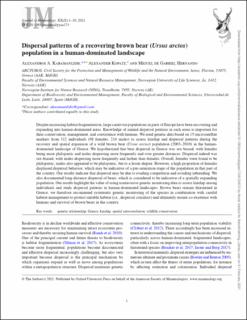| dc.contributor.author | Karamanlidis, Alexandros A. | |
| dc.contributor.author | Kopatz, Alexander | |
| dc.contributor.author | De Gabriel Hernando, Miguel | |
| dc.coverage.spatial | Greece | en_US |
| dc.date.accessioned | 2023-03-02T14:26:27Z | |
| dc.date.available | 2023-03-02T14:26:27Z | |
| dc.date.created | 2021-02-02T15:56:43Z | |
| dc.date.issued | 2021 | |
| dc.identifier.issn | 0022-2372 | |
| dc.identifier.uri | https://hdl.handle.net/11250/3055481 | |
| dc.description.abstract | Despite increasing habitat fragmentation, large carnivore populations in parts of Europe have been recovering and expanding into human-dominated areas. Knowledge of animal dispersal patterns in such areas is important for their conservation, management, and coexistence with humans. We used genetic data based on 15 microsatellite markers from 312 individuals (98 females, 214 males) to assess kinship and dispersal patterns during the recovery and spatial expansion of a wild brown bear (Ursus arctos) population (2003–2010) in the humandominated landscape of Greece. We hypothesized that bear dispersal in Greece was sex-biased, with females being more philopatric and males dispersing more frequently and over greater distances. Dispersal indeed was sex-biased, with males dispersing more frequently and farther than females. Overall, females were found to be philopatric; males also appeared to be philopatric, but to a lesser degree. However, a high proportion of females displayed dispersal behavior, which may be indicative of a pre-saturation stage of the population in that part of the country. Our results indicate that dispersal may be due to evading competition and avoiding inbreeding. We also documented long-distance dispersal of bears, which is considered to be indicative of a spatially expanding population. Our results highlight the value of using noninvasive genetic monitoring data to assess kinship among individuals and study dispersal patterns in human-dominated landscapes. Brown bears remain threatened in Greece; we therefore recommend systematic genetic monitoring of the species in combination with careful habitat management to protect suitable habitat (i.e., dispersal corridors) and ultimately ensure co-existence with humans and survival of brown bears in the country. genetic relationship, Greece, kinship, spatial autocorrelation, wildlife conservation | en_US |
| dc.language.iso | eng | en_US |
| dc.rights | Navngivelse 4.0 Internasjonal | * |
| dc.rights.uri | http://creativecommons.org/licenses/by/4.0/deed.no | * |
| dc.subject | genetic relationship | en_US |
| dc.subject | Greece | en_US |
| dc.subject | kinship | en_US |
| dc.subject | spatial autocorrelation | en_US |
| dc.subject | wildlife conservation | en_US |
| dc.title | Dispersal patterns of a recovering brown bear (Ursus arctos) population in a human-dominated landscape | en_US |
| dc.type | Peer reviewed | en_US |
| dc.type | Journal article | en_US |
| dc.description.version | publishedVersion | en_US |
| dc.rights.holder | © 2021 The Authors | en_US |
| dc.subject.nsi | VDP::Zoologiske og botaniske fag: 480 | en_US |
| dc.subject.nsi | VDP::Zoology and botany: 480 | en_US |
| dc.source.pagenumber | 494-503 | en_US |
| dc.source.volume | 102 | en_US |
| dc.source.journal | Journal of Mammalogy | en_US |
| dc.source.issue | 2 | en_US |
| dc.identifier.doi | 10.1093/jmammal/gyaa173 | |
| dc.identifier.cristin | 1885985 | |
| dc.relation.project | Andre: NGO ARCTUROS | en_US |
| dc.relation.project | Andre: Egnatia S.A. | en_US |
| dc.relation.project | Andre: Vodafone Group Foundation | en_US |
| dc.relation.project | Andre: Vodafone Greece | en_US |
| cristin.ispublished | true | |
| cristin.fulltext | original | |
| cristin.qualitycode | 1 | |

